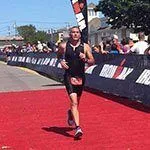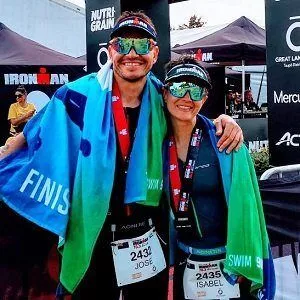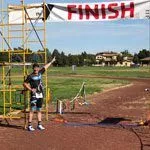Understanding Your 80/20 Triathlon Training Plan
by David Warden and Matt Fitzgerald
Be sure to read Intensity Guidelines for Triathlon and Understanding Your TrainingPeaks.com Structured Workout Plan after reading this article.
A training plan is only as good as its execution. Even the best training plan won’t help you much if you don’t understand it. This document offers guidelines and tips to help you get the most out of the 80/20 triathlon training plans.
Anatomy of a Workout
Each workout has three basic elements. The first two are duration/distance (how long the workout is) and intensity (how fast the workout is). The third is structure, which is how the workout is divided into segments of various lengths and intensities.
The workout descriptions you see in the training schedules provide duration/distance, intensity, and structure information in a condensed format. Let’s look at a cycling example:
Cycling Cruise Interval
5 minutes Z1, 20 minutes Z2, 3 x (5 minutes Z3/3 minutes Z1) 5 minutes Z2, 6 minutes Z1
We chose this example because it has a fairly complex structure. Nevertheless, it’s not at all difficult to decode and follow. The workout has three segments: a warm-up, an interval set, and a cool-down.
“5 minutes in Z1, 20 minutes in Z2,” is the warm-up segment. You’ll execute this part by cycling easily for 5 minutes at Zone 1 intensity and then for 20 more minutes at Zone 2 intensity.
“3 x (5 minutes in Z3/3 minutes in Z1)” is the interval segment. Cycle for 5 minutes in Zone 3, then slow down and cycle for 3 minutes in Zone 1, and repeat this sequence a total of three times.
“5 minutes Z2, 6 minutes Z1” is the cool-down segment. As in the warm-up, you’ll execute it by cycling easily for 5 minutes at Zone 2 intensity, then finishing for 6 minutes in Zone 1 (the final 6 minutes make the workout exactly 1 hour).
There is an almost infinite variety of workout structures, but if you understand how to interpret and apply the example we just covered, you can do the same with any other workout. Let’s now take a look at a swimming example:
Swimming Speed Play
250 yd Z1, 500 yd Z2, 5 x (50 yd Z4/20" rest) 500 yd Z2, 250 yd Z1
Like the cycling example, the swim workouts will generally follow the same format of warm-up, interval, and cooldown. Unlike most of the cycling and running workouts, however, the swim workouts will be based on distance, not time.
“250 yd Z1, 500 yd Z2” is the warm-up segment, which also doubles as your drill segment for swimming. Note that while all the swim workouts are measured in yards, you can swap yards for meters without compromising the overall integrity of the plan.
The interval segment of “5 x (50 yd Z4/20" rest)” means you will swim for 50 yards (or meters) in Zone 4, followed by 20 seconds’ rest, and repeat this sequence five times.
Finally, “500 yd Z2, 250 yd Z1” is, of course, your cooldown and drill segment.
Note that you have the flexibility to perform the workout at any point within the zone. For example, if the workout segment calls for Zone 1, and your Zone 1 heart rate is 115 to 129 bpm, you can perform the segment anywhere within that range. Continually performing workout segments at the upper end of a zone does not always lead to superior results. Sometimes appropriate recovery requires performing Zone 1 and 2 segments at the low end of the range. It is also best to perform moderate and high intervals consistently rather than intensely. Performing 5 intervals at mid-Zone 3 is preferred to performing 5 intervals at every point in Zone 3. Only when you are well-recovered and can perform intervals consistently is it recommended to execute the segment at the high end of the zone.
Swimming in Yards or Meters
While the 80/20 swim workouts default to measuring the workout in yards, it's easy to perform them in meters with one of four options. The easiest way is to change your pool size directly in the TrainingPeaks workout card. Second, our free 80/20 Workout Library includes all the swim workouts in 50-meter, 25-meter and 25-yard options, all ready to be downloaded to your compatible device. Third, our Team 80/20 Endurance subscriptions provide access to all 300+ swim workouts in both yards and meters format natively within TrainingPeaks. Finally, in a pinch, the swim workouts can be performed in meters even if the workout calls for yards, you will just be swimming 10% more than the plan calls for. This does not impact the 80/20 ratios, and an extra 10% swimming will not negatively impact the overall triathlon plan.
Getting to Know Your Zones
Perhaps the trickiest part of executing the workouts that are prescribed in a training plan is training at the right intensity in each segment. You will find complete guidelines for using our Seven-zone intensity scale in our Intensity Guidelines. But simply reading these guidelines alone won’t enable you to fully master the skill of training in the right zones. A certain amount of experience is also required.
Don’t worry: It doesn’t take long to develop a feel for the various zones, so that, for example, when you start a 3-minute interval in Zone 3, you are able to settle into the right effort level even before your heart rate monitor, power meter, or GPS watch confirms that you’re in the correct zone. Here are some specific tips for mastering each individual zone:
Zone 1
Zone 1 is a very low intensity. Staying within it usually requires that you actively hold yourself back to a pace that’s slower than your natural pace. The common exception is when a Zone 1 segment follows a tiring high-intensity effort. The important thing to understand is that it’s almost impossible to go too slow when you’re aiming for Zone 1, whereas it’s very easy and all to common to go too fast.
Zone 2
Zone 2 is fairly broad. You might wonder, “Where exactly within this zone should I be?” As a general rule, we encourage triathletes to go by feel. If you feel strong, swim, ride, or run near the top end of Zone 2. If you feel tired or sluggish, go ahead and allow yourself to exercise near the bottom end.
Zone X
Zone X is the trap that most triathletes fall into, and avoiding it is one of the key objectives of the 80/20 training approach. Just easy enough to not be uncomfortable, yet just hard enough to make you think you’re getting a good workout, this lukewarm intensity offers minimal value in increasing fitness while generating fatigue that interferes with recovery and with performance in subsequent intense workouts. Avoiding Zone X allows you to go harder on the hard days and gain more fitness. For half and full Ironman athletes, Zone X is used sparingly in the Specific phase of training to prepare you for your event, as Zone X does overlap with race intensity for these longer distances.
Zone 3
Zone 3 corresponds to lactate threshold intensity and marks the beginning of "legitimate" moderate to high intensity. Thinking in “threshold” terms can help you find this zone and stay in it by feel. The feeling of swimming, riding, or running in Zone 3 is often described as “comfortably hard,” or as the fastest speed that still feels relaxed. When you perform a Zone 3 effort, imagine there’s a cliff edge in front of you that represents the feeling of strain that accompanies faster speeds. Always stay one or two steps back from that precipice when training in Zone 3.
Zone Y
While Zone Y is not as detrimental as Zone X, this narrow intensity gap simply isn’t targeted by any of the tried-and-true workout formats. It’s a little too fast for threshold workouts, which traditionally target Zone 3, and a little too slow for high-intensity interval workouts, which offer more fitness bang for your workout buck when done in Zones 4 and 5.
Zone 4
Mastering this zone is a matter of connecting the pace, power, and/or heart rate numbers that define the zone with what it feels like to train at that power, pace, or heart rate, so that you are able to reliably start each zone 4 effort at the right intensity. If you mess it up the first few times, either going too slow or too fast, don’t sweat it. In fact, getting it wrong today is the best way to get it right tomorrow.
Zone 5
Zone 5 is almost always used in interval workouts similar to the one given as an example earlier in this article. This intensity zone ranges from the highest speed you can sustain for a few minutes all the way to a full sprint. So how fast should you actually go in Zone 5 efforts?
Tailor your effort to the specific format of the workout. The rule of thumb here is to stay closer to the bottom end of Zone 5 when these efforts are longer and hew closer to the top end when the intervals are shorter. For example, if a workout asks you to run a bunch of 90-second intervals in Zone 5, you’ll want to control your pace so that you are able to run all of the intervals at the same speed without slowing down. But if a workout prescribes a set of 20-second intervals, you’ll want to do them as relaxed sprints.
When using heart rate to measure intensity, you'll soon discover that your BMP takes 1-2 minutes to "catch up." As a result, you'll often not reach the heart rate target during very brief Zone 4 or 5 intervals. Pace and Power are more reliable methods to measure those high intensities. This issue can also be resolved by using the 80/20 Run and Bike Zones Garmin App, where you can have both real-time HR and your custom 80/20 Pace or Power zones displayed on your device at the same time.
You may wonder why a seven-zone intensity scale such as ours tops out at Zone 5. The reason is that in the original version of the scale, Zone X and Zone Y were not explicitly named. Instead these zones existed only as gaps between Zones 2 and 3 and between Zones 3 and 4, respectively. The first gap was created to ensure that low-intensity exercise efforts did not accidentally bleed into moderate intensity and the second to encourage athletes to commit to either moderate or high intensity. Nevertheless, many athletes found the gaps confusing, so we modified the 80/20 intensity scale in a manner that eliminates gaps and the confusion they cause while preserving the distinction between untargeted zones (X and Y) and targeted zones (1-5).
Cadence
Unless otherwise specified in the workout, we recommend that your cadence remain at 90rpm +/- 5 for all zones, on the bike and the run, with the slightly lower cadence allowed for Zone 3+ and the 90 or higher for Zone 1-2. There is no need to ever exceed 95rpm, but if your next race is expected to include significant hills, simulating an rpm of 75-85 is recommended.
Two and Three-a-Days
Some days have two workouts scheduled in the same day. On days with both a bike and run scheduled in the same day, it is not intended to be a brick workout (running immediately after the bike) unless specified otherwise. All days with both a bike and run should be done separately in the AM and then PM, or at least as far apart as possible, and in the order they are listed in your training calendar. If the bike and run must be combined, it is recommended to perform the workout with the most intensity first. Later in your plan, you will see BRO and BR workouts which provide guidance on optional and recommended brick workouts. When the two workouts in a day are a swim and another workout, it is recommended to swim first (so as to not swim while fatigued and compromise form). The swim and second workout do not have to be done AM and PM, and can be done back-to-back.
If you have added an 80/20 Endurance Strength Plan into your primary plan, you may see 3 workouts scheduled in a day. If so, the strength session can be moved to any other day of the week as long as there is at least one day between strength workouts (Monday and Wednesday, but not Monday and Tuesday, for example). If you must keep the strength workouts on the same day as the bike and run workouts perform the strength session last, if possible.
Whether two or three workouts in a day, the order is not critical. Don't worry if you can't perform the workouts in the order recommended above. It's better to get all workouts in, in any order, than to miss one altogether.
Perfection Is Overrated
While it’s important to execute workouts as they were intended to be done, it is not necessary that you execute every workout perfectly, and you shouldn’t beat yourself up when a given workout is not done to the letter. If the 2-hour ride on your schedule for today ends up being a 1:57:30, no big deal.
There’s a well-known story about a legendary running coach who always had his athletes run 187-meter hill repetitions. Another coach who admired this legendary coach emailed him to ask about this very precise distance. “Why 187 meters?” he asked, assuming there must be some deep physiological rationale for it. But the legendary coach came back with this answer: “Why 187 meters? Because that’s how long the hill closest to our training camp is!”
Keep this story in mind as you execute your 80/20 training plan. As with horseshoes and hand grenades, close is good enough.
The Importance of Listening to Your Body
There are some times when executing the workouts in your training plan to the very letter is a bad idea. For example, if you get three intervals into a nine-interval workout and you feel absolutely terrible, you should probably stop, or replace the remaining intervals with an easy jog. A helpful guideline to follow is this: If your interval pace or power is >3% less than it was in the previous interval, terminate the interval set and complete the remaining time in Zone 1 or 2. Similarly, if you wake up one morning with a really sore foot that hurts even to walk on, you should not run that day.
A training plan is really an attempt to predict the future. The many workouts that comprise a training plan represent what you should do if everything goes perfectly—that is, if there are no days when you feel really lousy or have an alarming sore spot. But things seldom go perfectly all the way through a training plan. It’s important that you listen to your body at every step of the process and make adjustments as necessary based on what your body is telling you.
What If You Miss Workouts?
Things happen. Busy days at work, out-of-town visitors, snowstorms, tendonitis, sharknados, the flu. What should you do if you miss one or more workouts due to one of these factors, or for some other reason?
The answer is that it depends very much on the specific cause and context of the interruption. As a rule of thumb, its best not to try to “make up” missed workouts. If you miss just one or two and you’re healthy, just pick up the schedule where you are. If you miss a bunch of workouts—especially for reasons of injury or illness—you should take at least a few days to ease gently back into training before you return to the schedule. And there may come a point where you’ve missed too much training to ever be able to safely return to the training plan. At that point you just need to hit the “reset” button and start a new plan when you’re ready.
Glossary of Workout Codes
| Acronym | Sport | Long Name | Description |
|---|---|---|---|
| CAe | Cycle | Cycling Aerobic Intervals | This cycling aerobic interval set is intended to prepare the athlete for the specific intensity and stress of half and full Ironman racing. The Zone 2 intervals should be done at the expected intensity of the athlete's next half or full Ironman. For new athletes, this will be low to mid Zone 2. For more experienced athletes, this intensity will take place in upper Zone 2. For advanced athletes, these intervals can even include Zone X, a rare exception to the 80/20 system. |
| CAn | Cycle | Cycling Anaerobic | When executed properly, this anaerobic interval set is the most effective method at increasing an athlete's VO2max. While VO2max is only one component an athlete's success, it is a direct predictor of endurance performance. Additionally, VO2 intervals have been proven to be more effective at improving overall economy than submaximal (threshold) or supramaximal intervals. Thus, a successful integration of these intervals in the General phase of training places the athlete in an advantageous position for the upcoming Specific phase, and ultimately their endurance performance results. These intervals are challenging, and the athlete must take great care to not perform them at a Zone 3 or Zone 5 intensity. The unusually high rest period compared to a Zone 3 work reflects the difficulty of the interval. The 80/20 principle is fundamental to executing these anaerobic intervals, as the athlete has deliberately trained easy 80% of the time in order to have the form necessary to maintain this repeated Zone 4 intensity. These anaerobic intervals are permission to go very hard. Be bold, but measured. A successful anaerobic interval set will have the athlete's output (pace, speed, power) be almost identical for each interval, in Zone 4, and without fade. |
| CCI | Cycle | Cycling Cruise Intervals | Muscular endurance is arguably the most important ability an endurance athlete can develop, and no other interval improves muscular endurance better than the cruise interval. The application of the cruise interval is broad. The only interval type appropriate for both the General and Specific phase of training, its benefit spans all triathlon distances. The 80/20 principle makes the cruise interval possible, by ensuring the athlete is sufficiently rested in order to achieve the required Zone 3 intensity. The cruise interval is the antithesis of Zone X. A successful cruise interval set has the output for each interval nearly identical to the previous, while maintaining solid Zone 3 intensity. Consider reducing the rest time from 3 minutes to 2 minutes and then 2 minutes to 1 minute if previous cruise intervals sets have been successful. |
| CF | Cycle | Cycling Foundation | Discipline is required for the cycling foundation set. If rested, the temptation is to drift into Zone X. However, save your energy for the 20% of the 80/20 plan, and stay in Zone 1-2 for this workout. High cadence. Avoid group cycling that will tempt you to go beyond Zone 2. |
| CFF | Cycle | Cycling Fast Finish | One of the few workouts designed with the intensity scheduled for the end of the workout, the intent is to expose the athlete to high intensity while slightly fatigued. |
| CFo | Cycle | Cycling Force | Because the cycling force intervals are so short, the athlete will have to often use perceived effort to gauge intensity, as HR may not reach Zone 5 prior to the interval ending. This workout is an excellent time to go very hard, but aim to have each interval with a similar output and avoid fading near the end of the interval. If hills are unavailable, the athlete can simulate by reducing cadence to 65-75rpm and occasionally standing. |
| CLI | Cycle | Cycling Long Intervals | Highly intense and rarely used, these heavy Zone 4 intervals mimic their fraternal twin, the anaerobic intervals (code CAn). The extended Zone 4 duration and reduced recovery interval reserve this workout for advanced athletes. |
| CMI | Cycle | Cycling Mixed Intervals | An exceptionally challenging workout. Half and full Ironman athletes may question the necessity for the suffering caused by this particular workout, but the raw increase in FTP will pay off in subsequent workouts and on race day. Used only in the General phase for half and full Ironman, it (unfortunately) spans into the Specific phase for Spring and Olympic training. Pacing is critical in the first Zone 3 interval, start in low Zone 3 and work your way up. |
| CRe | Cycle | Cycling Recovery | Take advantage of this day with active recovery. Avoid even Zone 2. High cadence. |
| CSI | Cycle | Cycling Short Intervals | Unlike the very similar cycling force interval (CFo) the cycling short interval is done with a high cadence and seated. Feel free to go hard. |
| CSP | Cycle | Cycling Speed Play | Not to be confused with the Zone 5 cycling short interval (CSI), the cycling speed play is done in Zone 4 with much shorter recoveries. If done in Zone 5, the athlete will fade. |
| CT | Cycle | Cycling Tempo | The cycling tempo workout does an excellent job at muscular endurance, and should be used as a method to either verify or re-establish current HR Zones. A difficult workout, pacing is key. Start slightly lower and finish stronger. Some brief forays into Zone 4 are acceptable. |
| RAe | Run | Running Aerobic Intervals | This running aerobic interval set is intended to prepare the athlete for the specific intensity and stress of half and full Ironman racing. The Zone 2 intervals should be done at the expected intensity of the athlete's next half or full Ironman. For new athletes, this will be low to mid Zone 2. For more experienced athletes, this intensity will take place in upper Zone 2. For advanced athletes, these intervals can even include Zone X, a rare exception to the 80/20 system. |
| RAn | Run | Running Anaerobic | When executed properly, this anaerobic interval set is the most effective method at increasing an athlete's VO2max. While VO2max is only one component an athlete's success, it is a direct predictor of endurance performance. Additionally, VO2 intervals have been proven to be more effective at improving overall economy than submaximal (threshold) or supramaximal intervals. Thus, a successful integration of these intervals in the General phase of training places the athlete in an advantageous position for the upcoming Specific phase, and ultimately their endurance performance results. These intervals are challenging, and the athlete must take great care to not perform them at a Zone 3 or Zone 5 intensity. The unusually high rest period compared to a Zone 3 work reflects the difficulty of the interval. The 80/20 principle is fundamental to executing these anaerobic intervals, as the athlete has deliberately trained easy 80% of the time in order to have the form necessary to maintain this repeated Zone 4 intensity. These anaerobic intervals are permission to go very hard. Be bold, but measured. A successful anaerobic interval set will have the athlete's output (pace, speed, power) be almost identical for each interval, in Zone 4, and without fade. |
| RCI | Run | Running Cruise Intervals | Muscular endurance is arguably the most important ability an endurance athlete can develop, and no other interval improves muscular endurance better than the cruise interval. The application of the cruise interval is broad. The only interval type appropriate for both the General and Specific phase of training, its benefit spans all triathlon distances. The 80/20 principle makes the cruise interval possible, by ensuring the athlete is sufficiently rested in order to achieve the required Zone 3 intensity. The cruise interval is the antithesis of Zone X. A successful cruise interval set has the output for each interval nearly identical to the previous, while maintaining solid Zone 3 intensity. Consider reducing the rest time from 3 minutes to 2 minutes and then 2 minutes to 1 minute if previous cruise intervals sets have been successful. |
| Rest | Rest | Rest | Athletes can consider adding a strength workout to this day, and beginner swimmers can consider adding a swim. However, rest is a critical element of improving fitness. Adding activity to this rest day is a high risk decision. Very few athletes, of any ability level, can maintain a 16+ week training program without regular days off. |
| RF | Run | Running Foundation | Discipline is required for the running foundation set. If rested, the temptation is to drift into Zone X. However, save your energy for the 20% of the 80/20 plan, and stay in Zone 1-2 for this workout. Avoid running with individuals who will tempt you to exceed Zone 2. |
| RFF | Run | Running Fast Finish | One of the few workouts designed with the intensity scheduled for the end of the workout, the intent is to expose the athlete to high intensity while slightly fatigued. An excellent simulation of a triathlon finish. |
| RHR | Run | Running Hill Repeats | Because the run hill repeats are so short, the athlete will have to often use perceived effort to gauge intensity, as HR may not reach Zone 5 prior to the interval ending. This workout is an excellent time to go very hard, but aim to have each interval with a similar output and avoid fading near the end of the interval. If hills are unavailable, a treadmill is recommended. If neither option is available, the prescribed intensity and duration can still be met. |
| RLI | Run | Running Long Intervals | Highly intense and rarely used, these heavy Zone 4 intervals mimic their fraternal twin, the anaerobic intervals (code RAn). The extended Zone 4 duration and reduced recovery interval reserve this workout for advanced athletes. |
| RMI | Run | Running Mixed Intervals | Complex in execution, the reward is high. This workout is best done pre-programmed into a watch (such as a Garmin). |
| RRe | Run | Running Recovery | Take advantage of this day with active recovery. Avoid even Zone 2. |
| RSI | Run | Running Short Intervals | Unlike the very similar running hill repeats (RHR) the running short interval is done on a flat surface. Feel free to go hard. |
| RT | Run | Running Tempo | The running tempo workout does an excellent job at muscular endurance, and should be used as a method to either verify or re-establish current HR Zones. A difficult workout, pacing is key. Start slightly lower and finish stronger. Some brief forays into Zone 4 are acceptable. |
| Rta | Run | Running Taper | Brief, but fast intervals to promote the taper. |
| SAe | Swim | Swimming Aerobic | For half and full Ironman athletes, these intervals can be used to simulate the intensity of race day swimming at upper Zone 2, with perhaps some intensity in Zone X. For Sprint and Olympic athletes, best to keep these at mid Zone 2, and use the more intense Zone 3+ workouts to prepare for racing. |
| SCI | Swim | Swimming Cruise Intervals | Designed to increase Critical Velocity, these intervals are done at upper Zone 3. Be careful not to get sloppy, form should not be sacrificed for what feels like more power. These are an excellent way to test different techniques, as the athlete can compare the effect of slight conscious changes to the swim stroke on each interval. |
| SF | Swim | Swimming Foundation | For half and full Ironman athletes, these workouts can be used to simulate the intensity of race day swimming at upper Zone 2, with perhaps some intensity in Zone X. For Sprint and Olympic athletes, best to keep these at mid Zone 2, and use the more intense Zone 3+ workouts to prepare for racing. |
| SMI | Swim | Swimming Mixed Intervals | Consider using different strokes for this workout. The purpose is intensity, and therefore the athlete is not limited to freestyle. |
| SRe | Swim | Swimming Recovery | Consider using multiple strokes for this recovery swim. Easy pace. |
| SSI | Swim | Swimming Short Intervals | This extremely high intensity and frequency will test your ability to maintain form at high speed. |
| SSP | Swim | Swimming Speedplay | This set should ultimately help improve Critical Velocity, and provide a significant challenge that helps the workout fly by! |
| ST | Swim | Swimming Tempo | The "big brother" of the swim cruise interval (SCI), take care not to start too fast and fade. Target your Z3 Critical Velocity and hold on to your form. |
| STa | Swim | Swimming Taper | If possible, in open water at the race venue or similar environment. Brief, but fast intervals to promote the taper. |
| STT | Swim | Swimming Time Trial | This set is designed to confirm or reestablish your Critical Velocity. Suppose you swim your four-hundred-yard test in 5:55 (5.92 minutes) and your two-hundred-yard test in 2:50 (2.83 minutes). Your critical velocity, then, is (400y – 200y) ÷ (5.92 min. – 2.83 min.) = 64.7 yards/ min. It is customary to express critical speed in the form of time per hundred yards. To make this conversion, divide one hundred by your critical velocity. In this example, 100 ÷ 86.6 = 1.55, or 1 minute 33 seconds. |












































































